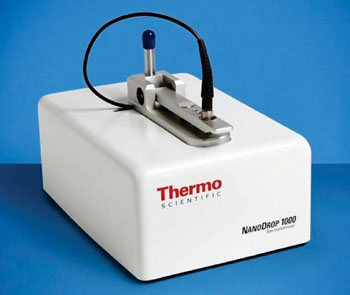Profiling Persistent Tubercle Bacilli Predicts Early Drug Efficacy
By LabMedica International staff writers
Posted on 20 Apr 2016
Posted on 20 Apr 2016
Success in tuberculosis chemotherapy is measured by the proportion of patients who fail therapy or who relapse after treatment is completed and therapy is monitored by counting Mycobacterium tuberculosis in sputum and assaying markers of drug toxicity.

Image: The NanoDrop ND-1000 UV-Vis spectrophotometer (Photo courtesy of Thermo Fisher Scientific).
Clinical or microbiological parameters, such as number of lung cavities or extent of lung cavitation, M. tuberculosis culture positivity at two months or bacterial load in sputum before the start of treatment, are associated with early treatment success but are poor predictors of treatment outcome.
Scientists at University College London (UK) and their colleagues recruited subjects with active pulmonary tuberculosis, human immunodeficiency virus (HIV) negative, sputum smear-positive pulmonary TB, in primary healthcare tuberculosis clinics in the Western Cape Province, South Africa. Clinical parameters measuring severity of disease, such as average chest radiograph (CXR) score and number of observable cavities were recorded and expectorated sputum was immediately collected.
Mycobacterial ribonucleic acid (RNA) was extracted from tuberculous sputa and microarray hybridizations were conducted using an M. tuberculosis complex pan-genome microarray. Mycobacterial RNA yield and quality were assayed using the Nano-Drop ND-1000 Spectrophotometer (NanoDrop Technologies; Wilmington, DE, USA) and the Agilent 2100 Bioanalyser (Agilent Technologies; Santa Clara, CA, USA).
Genome-wide transcriptional profiling was used to map the messenger RNA (mRNA) signatures of M. tuberculosis from the sputa of 15 patients before and three, seven and 14 days after the start of standard regimen drug treatment. The mRNA profiles of bacilli through the first two weeks of therapy reflected drug activity at three days with transcriptional signatures at days seven and 14 consistent with reduced M. tuberculosis metabolic activity similar to the profile of pre-chemotherapy bacilli. These results suggest that a preexisting drug-tolerant M. tuberculosis population dominates sputum before and after early drug treatment, and that the mRNA signature at day three marks the killing of a drug- sensitive sub-population of bacilli.
The authors concluded that their study defines the transcriptional signature of M. tuberculosis bacilli that have been expectorated in sputum after two weeks of drug therapy, characterizing the phenotypic state of bacilli that persist through treatment. They demonstrated that variability in clinical manifestations of disease are detectable in bacterial sputa signatures, and that the changing M. tuberculosis mRNA profiles zero to two weeks into chemotherapy predict the efficacy of treatment six weeks later. These observations advocate assaying dynamic bacterial phenotypes through drug therapy as biomarkers for treatment success. The study was published on April 7, 2016, in the journal BMC Medicine.
Related Links:








 (3) (1).png)




